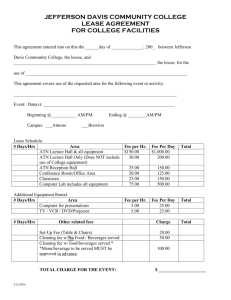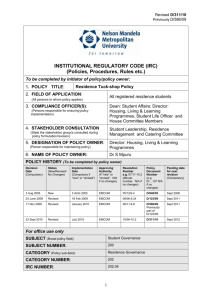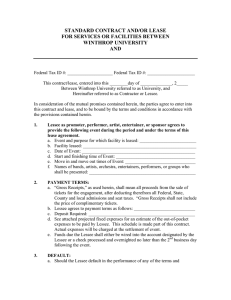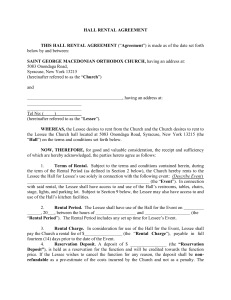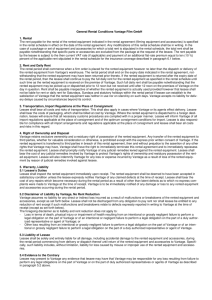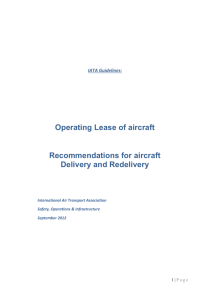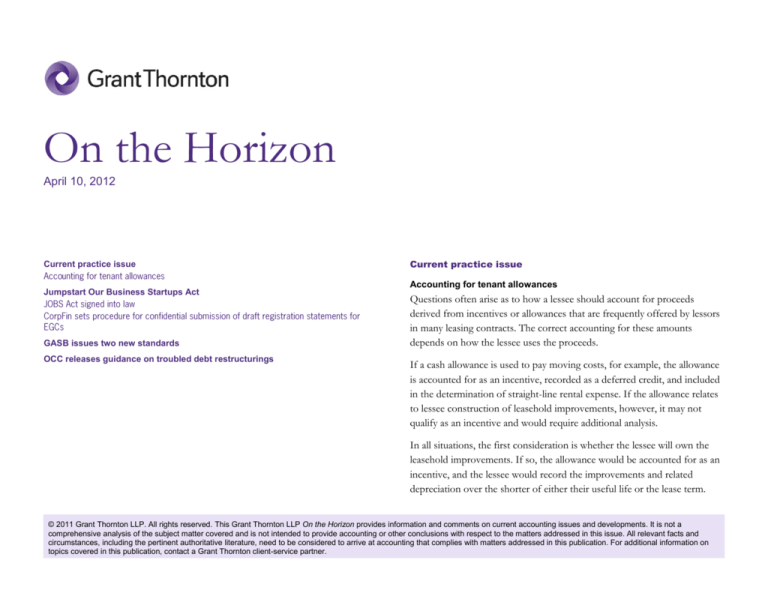
On the Horizon
April 10, 2012
Current practice issue
Jumpstart Our Business Startups Act
GASB issues two new standards
OCC releases guidance on troubled debt restructurings
Current practice issue
Accounting for tenant allowances
Questions often arise as to how a lessee should account for proceeds
derived from incentives or allowances that are frequently offered by lessors
in many leasing contracts. The correct accounting for these amounts
depends on how the lessee uses the proceeds.
If a cash allowance is used to pay moving costs, for example, the allowance
is accounted for as an incentive, recorded as a deferred credit, and included
in the determination of straight-line rental expense. If the allowance relates
to lessee construction of leasehold improvements, however, it may not
qualify as an incentive and would require additional analysis.
In all situations, the first consideration is whether the lessee will own the
leasehold improvements. If so, the allowance would be accounted for as an
incentive, and the lessee would record the improvements and related
depreciation over the shorter of either their useful life or the lease term.
© 2011 Grant Thornton LLP. All rights reserved. This Grant Thornton LLP On the Horizon provides information and comments on current accounting issues and developments. It is not a
comprehensive analysis of the subject matter covered and is not intended to provide accounting or other conclusions with respect to the matters addressed in this issue. All relevant facts and
circumstances, including the pertinent authoritative literature, need to be considered to arrive at accounting that complies with matters addressed in this publication. For additional information on
topics covered in this publication, contact a Grant Thornton client-service partner.
On the Horizon April 10, 2012
If it will not own the leasehold improvements, then the lessee would need to
evaluate whether it is involved with the construction of the leasehold
improvements. The lessee’s involvement could take many forms, but the two
most common forms are to be (1) primarily obligated under the construction
contract, or (2) responsible for cost overruns. The test to determine whether the
lessee is involved in construction is complicated and often leads to a conclusion
that the lessee is involved and is the deemed owner of the improvements during
the construction period. If the lessee is not involved in construction, the activity
is usually managed and financed by the lessor, and there is no accounting
impact on the lessee’s books.
If it is involved in the construction of the leasehold improvements, then the
lessee would account for the leasehold improvements as owned assets during
the construction period. When the assets are placed into service, the lessee
would analyze whether the assets can be derecognized using the accounting
rules for a sale-and-leaseback arrangement. If the transaction qualifies for saleand-leaseback accounting, it would then be evaluated to determine whether it
should be accounted for as an operating lease or a capital lease in the usual way.
But if the transaction fails to qualify for sale-and-leaseback accounting, the
improvements would remain on the lessee’s books, and the transaction would
be accounted for as a financing.
Real estate lease
Construction
allowance?
Yes
Yes
Lessee owns
improvements?
Record allowance as an
incentive and amortize
over the lease term
No
No
Lessee involvement
in construction?
Record allowance as a
cost reimbursement
The following flowchart summarizes this decision-making process.
Yes
Sale-and-leaseback
accounting
2
On the Horizon April 10, 2012
Jumpstart Our Business Startups Act
JOBS Act signed into law
On April 5, President Obama signed the Jumpstart Our Business Startups
(JOBS) Act into law. The JOBS Act is intended to foster job creation and
economic growth by assisting smaller companies in accessing the capital
markets.
The JOBS Act creates a new category of issuers called “emerging growth
companies” (EGCs). An EGC is generally an issuer with annual gross revenues
of less than $1 billion during its most recently completed fiscal year. However,
an issuer cannot qualify as an EGC if its first sale of equity securities pursuant
to an effective registration statement occurred on or before December 8, 2011.
An EGC is afforded certain reduced regulatory and disclosure requirements for
up to a maximum of five years following its equity initial public offering (IPO).
Certain of those accommodations are available only in connection with an IPO
registration statement, and others extend to other registration statements or to
periodic or other reports. Certain of the accommodations available to an EGC
include
Providing only two years of audited financial statements in its equity IPO
registration statement
Excluding selected financial data for any period prior to the earliest audited
period included in its equity IPO registration statement
Complying with any new or revised accounting standards when they
become effective for companies that are not issuers
Scaling executive compensation disclosures to the level provided by smaller
reporting companies
Submitting draft equity IPO registration statements for confidential review
by the SEC staff prior to public filing
Providing temporary exemption from
Section 404(b) of the Sarbanes Oxley-Act, which requires auditor
attestation regarding a company’s internal control over financial
reporting
Any future PCAOB rules, if adopted, requiring mandatory audit
firm rotation or supplements to the auditor’s report
Certain current and future executive compensation–related
disclosures
An issuer continues to maintain its EGC status until the earliest of (1) the
last day of the fiscal year in which it had total annual gross revenues of $1
billion or more, (2) the last day of the fiscal year following the fifth
anniversary of its equity IPO, (3) the date on which it has, during the
previous three-year period, issued more than $1 billion in non-convertible
debt or, (4) the date on which it becomes a “large accelerated filer.”
Other provisions of the JOBS Act that are not limited to EGCs include
increasing the Regulation A offering threshold from $5 million to $50
million and raising the Securities Exchange Act of 1934 Section 12(g)
registration threshold from 500 to 2,000 shareholders with certain nonaccredited investor limitations for issuers that are not banks and bank
holding companies.
CorpFin sets procedure for confidential submission of draft
registration statements for EGCs
The staff of the SEC’s Division of Corporation Finance (CorpFin)
announced that until a system for electronic submission of confidential
filings of EGCs is in place, the confidential filings should be submitted
either in text-searchable PDF format on a CD/DVD or in paper form. This
requirement applies whether the issuer is a domestic company or foreign
private issuer. CorpFin will then contact the issuer to confirm receipt and to
3
On the Horizon April 10, 2012
notify it of the review office to which the registration statement was assigned.
GASB issues two new standards
The Governmental Accounting Standards Board (GASB) recently published the
following two accounting standards:
Statement 65, Items Previously Reported as Assets and Liabilities, which clarifies
the presentation of deferred outflows of resources and deferred inflows of
resources
Statement 66, Technical Corrections – 2012 – an amendment of GASB Statements
No. 10 and No. 62, which eliminates inconsistencies in previously issued
standards
OCC releases guidance on troubled debt restructurings
The Office of the Comptroller of the Currency (OCC) recently released
OCC 2012-10, “Troubled Debt Restructurings,” to address numerous
queries received from bankers and examiners on the accounting and
reporting for troubled debt restructurings (TDRs), especially for loan
renewals and extensions of substandard commercial loans.
OCC 2012-10 reviews the authoritative guidance on identifying a TDR,
including the changes codified in Accounting Standards Update 2011-02, A
Creditor’s Determination of Whether a Restructuring is a Troubled Debt Restructuring.
It also discusses how to account for the loan after it has been identified as a
TDR.
Both of these Statements are effective for reporting periods beginning after
December 15, 2012. In both cases, early adoption is permitted.
4


